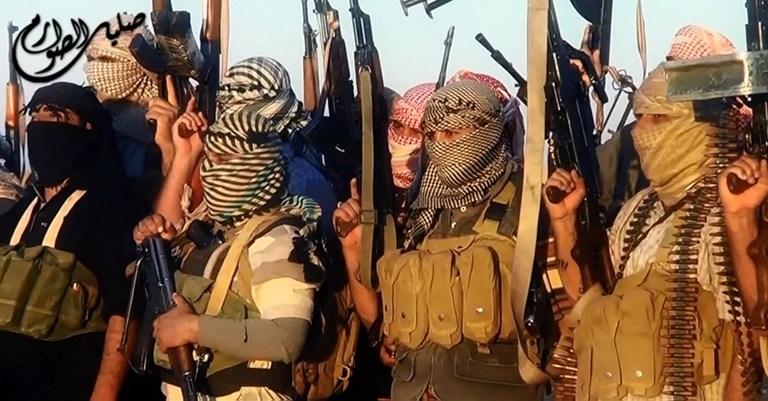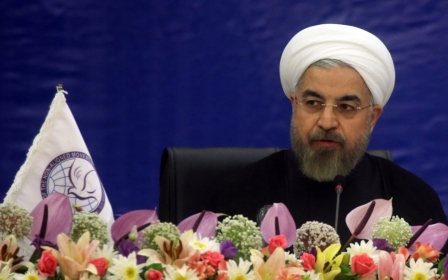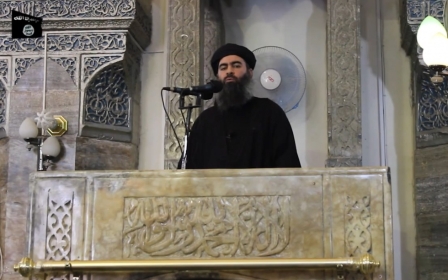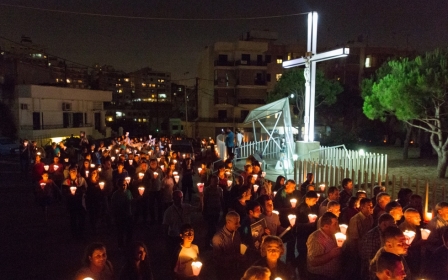
Democracy, not bombing, is the answer to IS
The rapid rise of the Islamic State (IS), its effectiveness as a fighting force and its declaration of a caliphate have generated global anxiety. Countries traditionally at odds are drawing together to face the new threat. The Saudis, the Iranians, the Russians and the Americans are all worried of the potential danger that this group poses to the world order.
The Americans, who ‘liberated’ Baghdad a decade earlier, have now been invited to protect it. The armies they helped build and train - both in the south and in the north of the country - appear incapable of stopping IS. Many now wonder how did this happen and what the US could do now to stop the militant advance.
The answer is simple. IS’s strength comes from the misguided policies of America and other regional players (especially the Iranians and the Saudis). The failure of these players to recognise that war alone cannot defeat ideas and provide alternative worldviews is remarkable. Aerial raids and ground bombardments may destroy pick-up trucks, tanks, and houses but they will never obliterate ideologies. To the contrary, they often create more grievances and add emotional fuel to ideological battles.
The question of what the US could do to solve the crisis in Iraq is based on the false assumption that IS emerged in the absence of an American intervention. The opposite is true. IS was born under the American occupation of Iraq and grew as the Americans worked to eradicate them. But it is precisely these bombings, alliances, and policies that have lead Iraq to where it is today. A hard look at that is a must before gullibly cheering bombers as they bomb again.
In a region where corrupt leaders are the proselytisers of the global order, where local attempts to affect change through peaceful means are confronted with local brutality and international intrigues, the extremism of the IS appears to be the logical outcome. Although claiming to fight extremism in a global alliance since early 1990s, America and its allies’ have not only created the most conducive environment for the proliferation of jihadist thoughts, but have managed to sideline groups that have jihadist tendencies but have the potential to be integrated into the system in the long term.
A great deal of bombing has been carried out in the past 20 years in the region and the American bombers have never left the skies of Iraq. Yet, the result is now plain to see. More bombings will only create smaller victories to celebrate now and bigger tragedies to mourn later. America’s victories against the jihadists are quite revelatory.
Chasing past ghosts and missing future challenges
In early May 2011, the US administration declared that its special forces had carried out a raid in Pakistan and successfully killed Osama Bin Laden. In Washington and in several capitals in the Middle East, the mood was one of celebration. Although al-Qaeda has not been able to carry out a major attack outside the zones of conflicts in Iraq and Afghanistan, the raid on Bin Laden’s compound was seen as a major blow to the jihadists around the world and a triumph to the US’s long global war on terror.
A tone of triumphalism spread among Western commentators and the advocates of the secular order worldwide, even those who have built their credentials on a steady doze of anti-US rhetoric.
Bin Laden was a problem for America and the world order it led, not because his organisation had amassed significant military capabilities or had held strategic territory. Instead, the threat that Bin Laden represented was different and could not be countered by conventional force. His threat was essentially psychological and discursive.
Despite the means at the disposal of the US and its allies, Bin Laden’s discursive threat continued to proliferate and the war of ideas has raged ever since.
While assuring Muslims that Bin Laden was given a proper burial, America took all the care to keep his burial site hidden in order to prevent militants having a shrine to visit. But the jihadists are not in the business of shrine visiting. They have destroyed most of the shrines of saints and prophets in the areas they have captured. The jihadist spirit he rekindled, is much more important to them than Bin Laden’s shrine could ever have been.
Before they killed him, they US gave Bin Laden his most precious gift: their invasion of Iraq.
Bin Laden - who vowed that the children of Arabia would teach America lessons that would make Vietnam War look like a picnic - was able to see the fiasco of Iraq and the proliferation of jihadist enterprises across the world.
Within 18 months of the fall of Baghdad, a branch of al-Qaeda was established in Iraq, creating the nucleus of what in January 2006 became a broad umbrella of jihadist organisations.
The umbrella, the Shura Council of the Mujahedeen, initially comprised only nine of the various Sunni insurgent groups in Iraq but attempts to draw more actors accelerated. In June 2006, the more cohesive alliance of al-Mutayyabun emerged under the leadership of Abu ‘umar al-Baghdadi (not to be confused with Islamic State leader Abu Bakr al-Baghdadi.)
By December, all jihadist groups espousing a trans-border caliphate dream created the Islamic State of Iraq (ISI), signaling a greater unification and confidence, despite the rise of US-backed tribal Sahawat alliance.
Often lost on non-specialists is the fact that al-Qaeda in Mesopotamia became a subgroup within this larger organisation, constituting the embryo of that would late become the Islamic State in Iraq and Syria (ISIS) and most recently, the Islamic State (IS).
This was a significant milestone in the jihadist project. Both Bin Laden and current al-Qaeda head Zawahiri told their followers that the centre has now shifted to Iraq.
In the words of Zawahiri: “The Islamic State represents an advanced step, bigger than the various groups, toward the establishment of the Caliphate.”
Both Zawahiri and Bin Laden promptly came to refer to then leader Abu ‘umar al-Baghdadi as the ‘commander of the faithful’.
Although the relationship between al-Qaeda and the Islamic State in Iraq would sour after the rise of Abu ‘umar al-Baghdadi, Zawahir’s endorsement shows not only that the jihadists were taking conscious steps toward their greater goal but that the Iraqi invasion had given them a chance to draw near to Baghdad with all its strategic value and historical symbolism.
So while the Americans went chasing the apparition of Bin Laden in the remote town of Abbottabad, their excitement was masking the faint symbolism of the act and did not stop the jihadists in their tracks. While America looked to Pakistan, the jihadists were reliving their history, firmly transfixing their eyes on the capital of Harun al-Rashid.
Another “Mission Accomplished” moment
Many Western intellectuals and journalists have at some point or another mocked Bush’s famous declaration of “Mission Accomplished.” But there were many celebrated victories in America’s war on terror that appear now to have been just as misguided.
The assassination of Bin Laden was only one. The assassination of Abu ‘Umar al-Baghdadi and Abu Hamza al-Muhajir earlier in 2010 was also an event that received much fanfare. Significant as it was, the event paved the way to the rise of Abu Bakr al-Baghdadi.
Rather than being a crippling blow to the Islamic State in Iraq, the assassination of the leading council in 2010 would prove to be transformative to the state. Instead of further bleeding his organization in a lost urban warfare, Baghdadi pulled his men out of urban centres and devised a few tactics that would prove effective in crippling the sahawat alliance, which brought his group to the brink of collapse. From their camps in remote desert areas, Abu Bakr al-Baghdadi’s men would focus on intelligence gathering about senior officers in Iraqi army’s elite units and the leaders of sahawat before proceeding to liquidate them as they slept at their homes.
Moreover, sending suicide missions to the homes of the leaders of the sahawat at dawns, at sunsets, during social gathering and during political campaigns served to send a reminder of the inescapability from the wrath of the ISI. These tactics of terrors worked and a few tribal leaders were willing by mid-2012 to work with Maliki or to provide information for the drones operators. Iraqi army officers working in the Sunni areas also became timid and left the Islamic State of Iraq to act with impunity.
When the sorcerer confronts his genie
While conducting a successful war of attrition and terror in the northern and western areas of Iraq, the desert fox, Abu Bakr al-Baghdadi, received a proposal from one of his Syrian disciples to take a part in the war raging in Syria. Al-Baghdadi, who already had his sleeper cells in a number of Syrian towns, accepted the proposal and sent the man, Abu Muhammad al-Jawlani, with a list of contacts to facilitate his mission.
The lure of weakly defended military bases with various assortments of lethal weapons would eventually drag in more and more of Baghdadi’s men. As the Iraqi army, Iranian senior military officers, and Lebanese and Iraqi Shi’i groups came to Syria to the rescue of the embattled Assad, the lines separating Baghdadi’s war in Iraq and the Syrian one became blurred enough to justify an imagined contiguous Sunni state across the border.
The pace of the events in Syria was much faster than the long-term plan of establishing a caliphate in Baghdad. After the dream of a cross-border Sunni state in Iraq and Syria had become the subject of conversations in Sunni homes and some intellectual circles, Abu Bakr al-Baghdadi started to believe it and set out to create it. The declaration was surprising to his most senior commander in Syria, Abu Muhammad al-Jawalani, who - although dismayed by the declaration - remained loyal to his superior. But that tension, made public by both the statement of al-Baghdadi and al-Jawalani’s response, was not lost on their opponents. They wasted little time to exploit it.
What doesn’t kill IS makes it stronger
The current boost in the power and confidence of the IS comes at the heels of the failure of the most complex attempt (and to-date the most secretive) to replicate the Iraqi Sahawat experience in Syria. There is now some evidence to suggest that a plan was put forth by the intelligence apparatuses of amalgam of nations in the spring of 2013, aimed at prolonging the life of the Assad regime and drowning the various jihadist groups into an endless fratricide inferno.
As the Iranians and Russians came to the conclusion that their support for the Syrian regime was unlikely to prevent its ultimate collapse, they started to look for unconventional solutions. By then, Assad had had experimented with various methods to earn international support by painting his enemies as lunatics, and himself as a protector of minorities against cleansing. This generated some sympathies globally with the regime, but not quite enough to offset the images of his brutality against the Syrians.
Around this time, it appears that the US intelligence community had concluded that the Syrian regime was not going to hold very long and that a mosaic of Islamists groups, concealing their affiliations and intentions, would replace him. But alarmingly the American project, working with Qatar, Saudi Arabia, Turkey and France, to try create a secular alternative to Bashar failed. The project was plagued from the beginning with conflicting interests and the lack of realism.
Not only was there the bitter Saudi-Qatari feud on what role the Muslim Brothers should play in the future Syria, but there were more significant hurdles on the ground. The groups fighting in Syria continually rejected almost every leadership proposed through this project, even the Muslim Brothers. For most Syrians working against Assad, the Muslim Brothers’ leadership has become European and accommodationist to the West, and by extension to the regime itself. France’s insistence (which was also Russia’s position) that the Alawites must be included in the post-Assad world added an extra obstacle, although a miniscule one.
The recognition that the Syrian revolution - despite its bloody road - may succeed in establishing an Islamist regime, the two opposing camps (Syria, Iran and Russia on one side, and US, Saudi Arabia, Turkey, Qatar, and France on the other side) converged. The UAE played an important role as locus of an international intelligence hub and invited their Israeli counterparts. The Saudis and the Qataris used their influence with some of the Islamists to create a rift in their camp and animosity to IS - then known as ISIS.
The Syrian regime and groups loyal to him inundated the camps of the Islamists with fake jihadists and hundreds of these carried out two types of operations: 1) assassinations of key figures in IS; and 2) senseless suicide bombing - IS’s favored tool - against many civilians targets to draw more suspicion to IS. As a reaction, foreign fighters, thought to be behind these attacks, were subjected to intense campaign of reprisals: many of their men were killed, their camps looted and some of their women were raped. This resulted in a sharp bifurcation in the most organized Islamic group, IS. One side withdrew from IS and accepted a more modest goal of Syria only, in line with the other Syrian groups. This was the camp of al-Jawlani and his Jabhat al-Nusra - although this never in fact brought him the pleasure of the West. His group continued to be seen as a terrorist group.
Although the mother organization suffered major setbacks in the initial fratricide, the IS quickly resorted to the tactics it had perfected in Iraq and carried out unrelenting liquidation and suicide bombing missions. Much like in Iraq, these tactics succeeded and those who allied against it - fearful for their lives and those of their loved ones - came begging to cooperate. As Western minds, and regional intelligence agencies were intoxicated over their victory in Syria and their eyes momentarily turned to Egypt to abort a different Islamist dream, IS regained the initiative and emerged victorious.
Its recruitment drive would also benefit from the success of a corollary alliance to stifle the Islamists. But this time, the target was not jihadists but rather the democrats of Islamism: the Muslim Brothers. The success of the Israeli, American, Saudi and Emirati plan in the summer of 2013 to oust the president of Egypt, and the bloodletting, which ensued, brought many Egyptian youths, including many of the ‘soft’ Islamists to Syria and to IS’s side.
That wasn’t the only thing that Egypt’s coup did to help IS. Although the Western hands remained invisible, the hands and dollars of their allies were exposed. This played into the hands of jihadists and their belief that the West would never allow Islamists to rule regardless whether through democratic institutions or by other means. Egyptians who weren’t able to reach Syria joined the group (loosely affiliated with IS in the Sinai desert) of Jama‘at an-Sar bayt al-Maqdis. But more important than those who joined jihadist groups, the number of those in the Muslim world convinced that jihadism is the way to go is on the rise and it would continue to do so in the near future commensurate with the failure of Sunni leaders and the Western opposition to change in Arab lands.
The jihadist climax
Moving from Syria with better weapons and further military experience into an area seething with tension, the IS scored rapid victories and captured enormous territories. The victory caught everyone by surprise, but the major surprise was it declaration that that it had become a caliphate representing all Muslims. As expected, the declaration was repudiated by most Muslims, mocked by some and embraced by a few. The movement’s declared objectives, its rapid victory over the Iraqi army, and most recently the Kurds, reverberated across the globe, provoked fear and drew in new actors. As the IS drew closer to the intelligence centres and key oil fields in the Kurdish north, the West became restive and decided to intervene.
Instead of the weakened armies it had confronted on the terrain, IS is now facing US aerial raids, for which it is ill prepared. It has neither an air defense system nor an air force. To further compound its problems, the French, Germans, Iranians and others promised to arm the Kurds and the Iraqi regime. The Iranians and the Saudis and the central government in Baghdad - forging a stranger than fiction alliance - are diverting significant amount of cash to instigate an uprising against IS. But the signs that this would work are so far dim.
Would war finish IS?
With air coverage, Kurds and the Iraqi forces are likely to make some success, but it is too premature to declare an end to IS. The US and its European allies are unlikely to send troops to the region and air force alone would only degrade IS’s military capabilities, especially its arsenal of armored vehicles, the drive of its men and their individual skills are unlikely to be worn easily. The intervention might play into the hands of IS in the long term, especially if the Kurds and the Iraqi army commits atrocities in Arab and Sunni towns as they recapture new territories.
For IS, there is nothing new in this. They have dealt with both the Americans and the Iraqis before. Its affiliate in Yemen, Ansar al-Shari‘a, has also dealt with this and has survived relentless attacks of US drones. It eventually managed to destroy the local network of informers, rendering the use of drones militarily meaningless. Afghanistan is another place where jihadists saw the use of both jetfighters and drones for a prolonged period. From the perspective of the US declared objectives, the situation is not any better. Taliban had continued to operate and its influence after over a decade of war is hardly on the wane. It is true, that unlike Afghanistan and Yemen, Iraq is an open desert. Therefore, it is likely that despite its expertise, IS may retract temporarily and its opponents may advance. But it is eventually bound to resurface, as the gaps dividing Iraq sects have become almost unbridgeable.
The other alternative
Wars led to the current state of affairs and so have the intrigues. Intrigues against the jihadist enterprise have slowed, but not defeated, the jihadists. The jihadists have weathered the Sahawat phenomena in Iraq and have developed strategies of terror to leave a few incentives for civilians to join them.
But while wars and intrigues are not constructive, candor is. Most wars and intrigues have been driven by the inexplicable Western fear of a democratic breakthrough in the Muslim world. Countries were invaded and regimes were toppled to prevent the Muslim masses and their elites from freely experimenting with systems whose economic and legal comportments are shaped by their cultures and belief. Popular Muslim elites and activists have shown a remarkable flexibility accepting to work with and within Western institutional norms. But the West has rejected anything short of ideational surrender. It has done worse. It rejects to candidly confess this fact.
This obdurate stance, and the hypocrisy around it has enormously aided the jihadists, discredited moderates and have revived in some quarters a rigid Islamic ‘Asabiyya-- to use the language of Ibn Khaldun. More and more Muslims, predominantly youth, but others as well, are convinced that without a jihadist uprising, the West will continue to stifle any attempt at democratisation in the Arab world. The recent coup in Egypt, the ongoing attempts to annul the effect of the Libya revolution, and the insurmountable economic and political pressures put before post-revolution Tunisia have strongly solidified that feeling. One has only to sift through the warring Muslim cyberspace with a simple quantitative or qualitative methodological tool to discern that trend.
For the sake of future peaceful and equitable world, a success of an alliance to defeat or moderate IS, must be followed by a genuine re-assessment of Western policies vis-a-vis the Arab world and a discarding of the unjustified fear of Muslim democracies.
— Ahmed Meiloud is a PhD student at the School of Middle Eastern and North African Studies at the University of Arizona. His research interests include studying the various movements of political Islam across the Arab World, with special focus on the works of the thinkers, jurists and public intellectuals who shape the moderate strands of Islamism. He contributed this article to PalestineChronicle.com.
This views expressed in this article belong to the author and do not necessarily reflect the editorial policy of Middle East Eye.
Photo credit: IS fighters at a public rally in Iraq (AFP)
Middle East Eye propose une couverture et une analyse indépendantes et incomparables du Moyen-Orient, de l’Afrique du Nord et d’autres régions du monde. Pour en savoir plus sur la reprise de ce contenu et les frais qui s’appliquent, veuillez remplir ce formulaire [en anglais]. Pour en savoir plus sur MEE, cliquez ici [en anglais].




